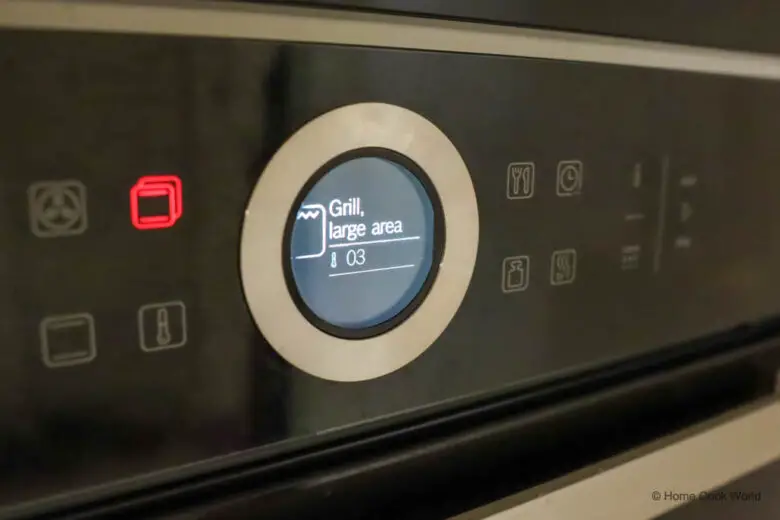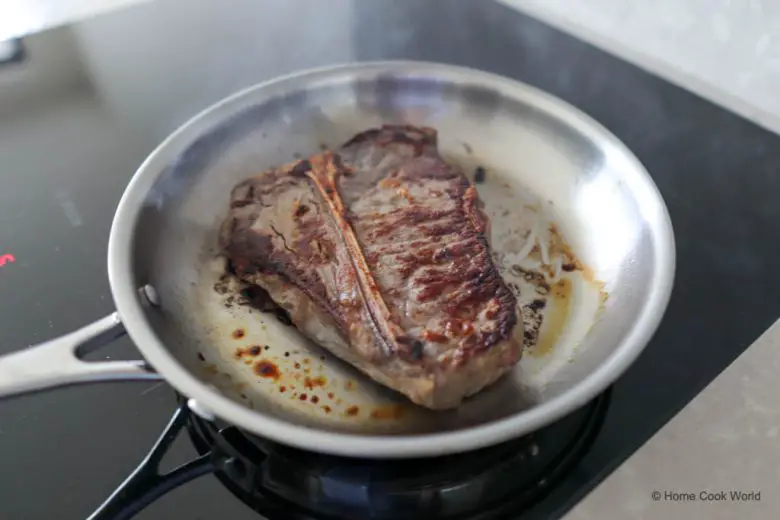Wondering whether you should throw that steak in a hot pan or put it under the broiler?
Broiling and pan-frying are two of the best ways to cook a steak, there’s no doubt about it. But some subtle differences exist between them, and they’re not always interchangeable. Which, as you can probably guess by now, is exactly what I’ll be talking about in this post.
Broiling and frying are dry-heat cooking methods that produce a neatly browned, deeply flavorsome steak cooked to perfection. Broiling takes place under the high heat of the broiler, and pan-frying in a preheated skillet on the stovetop.
When broiling, you’re relying on the direct heat of the heater panel above the steak to cook it. When frying steak in the pan, you’re using the heat that your stove—whether gas, electric, or induction—transferred to your frying pan.
Unless the recipe calls for it, you’ll probably choose pan-frying over broiling most of the time. Still, broiled steak has its merits, and its rightful time and place. Especially if you have family or friends over, and you prefer to spend your time talking to your guests rather than leaning over the stove to cook supper.
Thick-cut steaks are almost always better broiled than pan-fried. The direct, intense heat of the broiler can blacken and burn the outside of the meat long before it is cooked through on the inside.
Of course, you could always roast a steak at a gentler temperature, then finish it under the broiler to get that crispy, flavorful crust.
Here’s why that is, and what else you should know on the topic.
How to Broil a Steak

Broiling is a dry-heat cooking method in which you apply high, direct heat, which comes from your home oven’s top heating panel, to the steak.
Broiled steak has a pure, intensely meaty flavor that you can’t get from pan-frying, where the meat picks up a buttery, slightly creamy taste from the cooking fat. Nor from grilling, which yields smoky, BBQ-house-style steak.
Broiling is my cooking method of choice when wifey and I have family or friends over. It allows you to cook for a crowd without having to leave your guests for hours on end or reheat stale steak that you pan-fried ahead of time.
For best results, use a broiler pan:
The best piece of cookware for broiling is a broiler pan, also called a “roasting pan” or “roaster.”
These pans, distinctively heavy to the hand, are made of aluminum or stainless steel. Some are coated with a non-stick surface, and others have a cooking surface made of bare metal. When in doubt, go for the latter; an uncoated roaster can last you a lifetime, whereas PTFE coatings will wear out (and need replacement) in a few years.
Broiler pans are thicker than conventional baking sheets and come with a wire rack or ridged surface. The thickness keeps them from warping and allows them to retain and distribute heat, and the ridges lift your meats from the fats and juices that drip down and pool in the pan.
Always preheat your oven before broiling:
Every modern range has a broiler. On electric models, the heat comes from the top heating panel in the oven. On gas models, on the other hand, broiling is done in a heated drawer located right under the oven’s bottom heating panel.
Most ranges have only one broiler setting, which heats up to 500-550°F. Some higher-end models let you choose between low heat (400°F), medium heat (450°F), and high heat (500°F).
Regardless, you should always preheat your oven for at least 30 minutes before broiling. This rule of thumb—as a side note—applies to all food items, not just steak.
Prop open the broiler/oven door:
The problem with broiling is your oven’s thermostat, which will keep toggling the heating panel on/off as it detects that the temperature inside your oven or broiler drawer gets under/over 500°F.
Leaving the meat to cook in its residual heat is counterproductive to a good broil. You want steady, constant heat from your oven’s heating panel instead. Some experts recommend propping open the oven’s or broiler drawer’s door by an inch or two.
Doing so allows heat to escape, preventing the broiler drawer or oven from reaching its maximum operating temperature so that the heating panel stays turned on throughout the entire time.
Check for doneness every few minutes:
High heat broils meat faster but, without proper oversight, can dry it out and burn it just as quickly.
Unless the recipe says otherwise, it’s a good idea to broil steak in 2-3 minute intervals, checking for doneness at the end of each. Heat comes from the top—and cooks your steak one side at a time—so you’ll want to flip it over to brown it evenly on both sides.
If you’ve never used the broiler feature on your home oven before, it takes a few tries to learn the ropes. Broiling is tricky because the intense heat can scorch your steak on the outside, imparting it with an unpleasant and acrid taste, and leave it undercooked on the inside.
How to Pan-Fry a Steak

Pan-frying is a dry-heat cooking method in which you cook a steak to your desired level of doneness in a hot skillet, lightly greased with cooking oil.
Pan-fried steak browns extraordinarily well and forms a crispy, flavorful crust with a stronger taste than the crust you normally get from broiling. Some of that crust builds up in the form of food residue stuck to your pan, which you can easily release and turn into the most delicious pan sauce with the help of a cooking liquid.
When cooking in an abundance of oil or butter, you can infuse your steak with extra flavor by throwing a few cloves of garlic and some fresh herbs into the pan and using a tablespoon to baste the meat with aromatic and flavorful fat.
Don’t mistake pan-frying for searing:
You pan-fry a steak by cooking it for a few minutes on each side over medium to medium-high heat till it’s considered done and ready to serve. You rely on butter or cooking oil to give the steak juiciness and impart it with a creamy, slightly nutty taste.
When you sear a steak, you cook it briefly over medium-high to high heat on each side to give it a flavorful crust before finishing it as a braise, stew, or roast. You do so in a minimal amount of neutral-flavor cooking oil with a high smoke point, such as avocado oil or rice bran oil.
Use a heavy, uncoated skillet:
The best cooking vessel for pan-fried steak is a heavy, thick-bottomed skillet made of carbon steel, cast iron, or stainless steel. Preferably, one with an uncoated cooking surface.
A frying pan that matches this description will heat evenly and retain heat well. That’s an absolute must for keeping a steady cooking temperature, especially for those of you who have electric stoves that keep turning their coils or radiant heating elements on and off as you pan-fry.
There are a couple of reasons why it’s better to pan-fry steak in an uncoated skillet.
First, you can damage a PTFE- or ceramic-coated frying pan by preheating it empty. That’s a bummer because you need a hot skillet to get good browning and caramelization on your steak.
Second—and this is a conclusion I’ve come to through much trial and error—no matter how hard you try, you simply won’t get as crispy and as flavorful of a crust when pan-frying steak in a non-stick pan. Period.
Use medium to medium-high heat:
There’s no need to go crazy on the heat dial when you’re pan-frying steak. Overly high heat will burn the steak on the outside while leaving it undercooked on the inside.
How high of heat to use depends on a number of factors, including your stove and skillet. As I am writing you this, I have an induction cooktop in my home kitchen—and these things are more powerful than you may think. To prepare steak, I use heat setting 5 out of 9.
It took me more than a few tries to get there, but I’ve found this to be the ideal level of heat that doesn’t cause most of the cooking oils in my pantry to smoke, and that browns a steak without scorching it.
Suppose you haven’t figured this out for your stove and your cookware. Start with medium heat, see what results you get from the whole setup, and turn up the heat to medium-high only in case you’re not satisfied.
Preheat your skillet for 2-3 minutes:
To make that perfect pan-fried steak, you need a hot skillet. So, even when in a hurry, you have to preheat your frying pan for at least 2-3 minutes before you get cooking with it.
Contrary to what most people think, it doesn’t matter if you add oil to a cold or hot pan; each method has its ups and downs.
For example, I add a tablespoon or so of cooking oil to my pan before preheating it because, with oil in the pan, I find it easier to tell when it’s hot enough to cook in. (I know I’m there as soon as the oil starts to glisten and ripple by itself.)
Let the steak cook uninterrupted on each side:
As soon as your steak comes into contact with the hot pan, it will start to smoke and sizzle. Let it do so uninterrupted before flipping it over to the other side. Browning and caramelization take time to develop and, if you give them enough time, the meat will come out highly aromatic and deeply flavorful.
The most accurate way to tell if a steak is done is to use a meat thermometer. Insert the probe into the center of the meat and wait for 2-3 seconds to get a reading. Generally, 145°F is the safe minimum internal temperature for red meats and seafood. For poultry, that’s 165°F.
